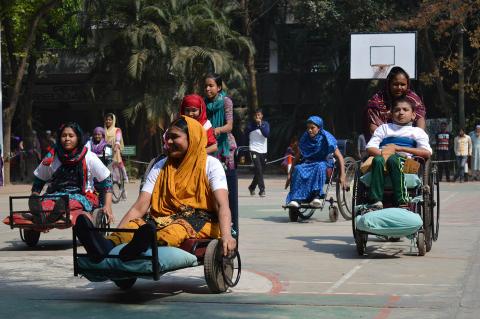You are in this section
Guest Blog: Sport can reach places where other aid and development programmes struggle. So why are we ignoring it?
Communications and Fundraising Manager, Mel Paramasivan, wrote a guest piece for Duncan Green's Oxfam Poverty to Power blog, which discusses the importance of sport in the international development agenda.
“Oh, that’s nice” was the patronising response from another delegate at an international women’s rights conference when I explained how sport is being used to engage out of school girls in Kenya in financial literacy programmes. ‘Nice’ is how I would describe the canapé I was eating at the time, not the life-changing experiences of young women now in education, employment or training and finding alternatives to early marriage and motherhood.
The Sport for Development (S4D) sector remains a backwater within international development yet playing sport can overcome almost every discriminatory label and engage and sustain the attention of children and young people in settings less formal and intimidating than a four-walled classroom. Where other interventions fail, sport provides a platform for interactive learning – as when football was used as a way to teach young boys about the importance of girls’ rights and to teach young girls about their own rights. And that’s without mentioning the obvious direct benefits in healthy lives and well-being.
Sport does not leave people behind and as people with disabilities face the challenge of being included in mainstream development, sport can break cycles of exclusion and segregation. In the Bahir Dar region of Ethiopia, sport has enabled people with disabilities to take on responsibilities and leadership roles. Eighteen year old Taye Asfaw went from ‘observer to player’ when the Sport for Inclusive Development Programme was launched and is now managing the local youth centre. The partnership between S4D charity, International Inspiration (IN) and local community organisation the Leonard Cheshire Foundation is a trailblazing integration of sport into community-based programmes, so successful that the model is ready to be scaled up across the country.
Sport is a second chance for those who have slipped through the cracks because of circumstances beyond their control and brings marginalised groups together to tackle the inequalities and injustices they face. Sport creates a special culture of unity and is omnipresent – you may not yet find clean water in every community in the world, but there will probably be a football match going on. So why has sport gone missing in development?
My colleagues have debated the issue extensively: how can sport become recognised in the SDGs? How can we get sport into the mainstream development agenda? What is the role of sport post-2015? My view is that sport will remain on the side-lines until the international development sector recognises the importance of culture and diversity.
Development culture’s stiff upper lip
Sport is a dramatic break from development tradition because it challenges conventional thinking that has largely excluded culture. International development has been shaped by great minds, but so far, they have all come from the fields of economics and politics. There is more to life (and the lives of poor people) than that, which is where sport comes in. Sport symbolizes the kinds of power shift we need both within communities and in development. The scale of work undertaken by S4D organisations does not rival even the smallest UN body or INGO; instead organisations work autonomously and independently, understanding and addressing local challenges. In Kilifi, Kenya (the canapé story) sport has shifted power from local chiefs and community elders to young coaches and girls.
Is sport just a middle-class distraction from the serious business of raising income levels and fighting for civil rights? To borrow from Bill Easterly – we need a little cynicism, sometimes – is S4D just a bunch of planners pursuing a grand vision of thousands of smiling children kicking around footballs? Absolutely not – it didn’t start with a UN bureaucrat with Development for All in one hand and a whistle in the other. The sector rose from the ground and has shifted, split and changed direction in twenty years of great contestation, of trial and error to develop models to work within existing structures that use sport and achieve development. Organisations like IN now look to move sport from an isolated intervention to being accepted as a mainstream development approach.
Sport is not the answer to everything (of course); sport is a means not an end. It is not a farming programme that directly produces food to address hunger, or an energy initiative to provide fuel, but it isn’t an afterthought either. There are, after all, lots of other development interventions that are more means- than ends- based.
Sport can also play a role in the bigger ‘grown-up’ stuff like political reconciliation and social cohesion – Lord Seb Coe argues it could help heal the wounds of the Paris attacks.
We’re all in this together
Sport has the potential to bring a strong and significant shift not only in development culture but how we talk about development and culture. The SDGs, like sport, come with a lot of jargon but at the heart of both are game changers and goals. To turn a blind eye and not offer a hand to sport is to ignore the kid on the side line, who could be a champion and inspire others. But we’ll never know unless we give them a chance

